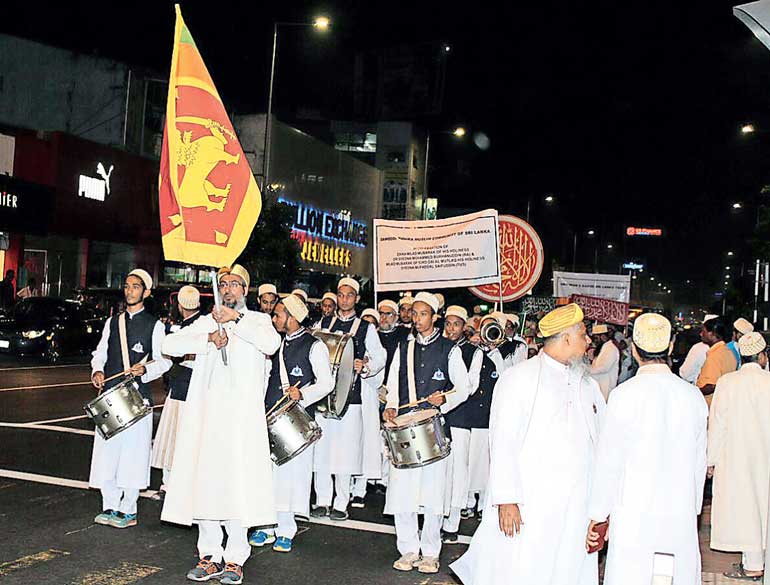Saturday Apr 27, 2024
Saturday Apr 27, 2024
Monday, 8 January 2018 00:00 - - {{hitsCtrl.values.hits}}
By P.K. Balachandran
Along with the rest of the community across the globe, the Bohras of Sri Lanka took out a colourful procession in Bambalapitiya, Colombo, on Saturday, to celebrate the birthday of their Spiritual Leader Dr. Syedna Mufaddal Saifuddin.

The community which gathered at their mosque on Adamally Avenue, heard sermons and after singing the Sri Lankan national anthem took out a colourful procession. A massive cake was also cut on the occasion.
Writing in the website www.asianimage.co.uk on the Bohras of Sri Lanka, Tuan M. Zameer Careem says that the British colonial era was the curtain raiser for the arrival and settlement of expatriate communities in Sri Lanka. The Borahs, were among the notable mercantile communities which reached the Lankan shores during the 19th century.
The Bohras were originally traders who traced their lineage to the North Western part of India. They settled in British Ceylon especially in the coastal belt. But Colombo has been their stronghold for long.
The Borahs in Sri Lanka believe that their ancestors were originally Gujaratis, and their vernacular, which is a dialect of Gujarati known as Dawat-ni-Zaban, helps corroborate their claim.
The Bohra familes, Adamalee and Adamjee Lukmanjee, trace their roots from Kutch district in Gujarat. It is interesting to note that the term ‘Bohra’ is derived from the Gujarati word for trade and their ancestral livelihood has survived to this day. Pettah, in North Colombo, a place bristling with bazaars and markets exemplifies the influence of Borahs in local trade. They are the best known paper merchants in the country.

The Bombay Sweet Marts, haven for those with a strong appetite for sweets, were introduced to the country by the Borahs who still continue the business. Bombay sweets are delicacies introduced by the Borahs in Sri Lanka. Some of their mouth-watering delicacies are: gulab jamun, jelebi, halwa, laddoo, bhoondhi, rasagulla, muskats and so on.
Their cuisine is indeed unique. Unlike other locals, they are noted for the extensive use of ghee when cooking. They use long grain rice known as ‘Basmati’ which is traditionally from North India and Pakistan. The population is concentrated in the Bambalapitiya area of Colombo and their number in Sri Lanka is around 2,500. Similar to the Parsis, Bharathas, Burghers and Malays, the Bohras have their own distinguishing factors which range from traditional clothes to patronymics.
The men are identified by the special headgear known as ‘Bohra cap’ which is adorned with a distinctive gold band while the female-folk are clad in a burqa known as ‘ridah’ in a wide range of colours.
Their patronymics include Abbasbhoy, Adamjee Lukmanjee, Akbarally, Davoodbhoy, Fazal Abbas, Fazleali, Hebtulabhoy, Jafferjee, Jeevunjee, Miajee, Moosajee, Nathani, Rehmanjee and Shethwala. It is noteworthy that all these are established names in the trade industry, especially in import and export.
The Bohras are noted for their unique physiognomy as they are much lighter in complexion compared to other locals, and in appearance they are similar to North Indians.
The firm established by Carimjee Jafferjee family in 1831 is considered the oldest Bohra firm in the country with branches all over India and even extending to Mauritius.
The company exported all types of local commodities and imported rice, sugar, flour, pepper, and groceries. Likewise, other Bohra families have also left their mark in international trade. Through the years, the Sri Lankan Bohra community has produced several doctors, engineers, lawyers, accountants, business consultants and economists in the country.
Unlike other minorities they have erected their exclusive places of worship and set up educational institutions.
The Bohras are Muslim and are of the Shia sect. Their forefathers of the community had erected their mosques in Jaffna, and Galle besides Colombo.
The ornate mansion in Cinnamon gardens Colombo known as ‘Saiffee Villa’ which was the former ‘Lakshmi Giri’ residence of Richard de Soysa, son of philanthropist Sir Charles de Soysa, is at present a centre for the Dawoodi Bohra community in Sri Lanka, and the venue of religious gatherings.
The Villa is named in honour of the pious Islamic scholar, Syenda Taher Saiffuddin and the current owner of this sprawling mansion is the family of Adamjee Lukmanjee who purchased the lavish property in 1978.
The Bohras form a close knit community in the country and through the years they have lived in friendly brotherhood with other communities.